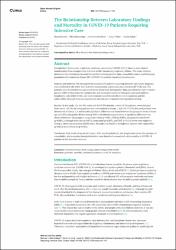The relationship between laboratory findings and mortality in COVID-19 patients requiring intensive care
Künye
Bahceci, I., Mercantepe, F., Duran, O. F., Yildiz, S., & Sahin, K. (2023). The Relationship Between Laboratory Findings and Mortality in COVID-19 Patients Requiring Intensive Care. Cureus, 15(6), e41194. https://doi.org/10.7759/cureus.41194Özet
Introduction: Severe acute respiratory syndrome coronavirus 2 (SARS-CoV-2) shows a wide clinical
manifestation from asymptomatic infection to life-threatening respiratory failure. This study aimed to
determine the relationship between the survival and demographic data, comorbidity status, and laboratory
parameters of coronavirus disease 2019 (COVID-19) patients requiring intensive care.
Material and methods: We retrospectively analyzed 236 patients requiring intensive care whose diagnosis
was confirmed by the SARS-CoV-2 reverse transcription-polymerase chain reaction (RT-PCR) test. The
patients were divided into two groups in terms of survival. Demographic data; procalcitonin and C-reactive
protein (CRP) levels; leukocyte, lymphocyte, and neutrophil counts in hemogram and neutrophil-tolymphocyte ratio (NLR) levels; and lower respiratory and blood cultures were examined, and the
relationships between these parameters and survival were evaluated with hypothesis testing.
Results: In the study, 156 (66.1%) males and 80 (33.9%) females, a total of 236 patients, were included.
Sixty-seven (28.3%) surviving patients were determined as Group 1, and 169 (71.7%) deceased patients were
determined as Group 2. A statistically significant difference was found between the groups in terms of mean
age (p<0.001) and gender distribution (p=0.011). In laboratory parameters, a significant difference was
observed between the groups in lymphocyte count (p=0.001), NLR (p<0.001), and procalcitonin levels
(p<0.001). Although leukocyte (p=0.075), neutrophil (p=0.031), and CRP (p=0.112) levels were higher in
Group 2, there was no statistical difference. Mortality was found to be higher in patients with comorbidity
(p=0.012) or co-infection (p=0.002).
Conclusion: High levels of neutrophil count, NLR, and procalcitonin; low lymphocyte count; the presence of
comorbidity; and secondary bacterial infection were found to be associated with mortality in COVID-19
patients in the intensive care unit.


















